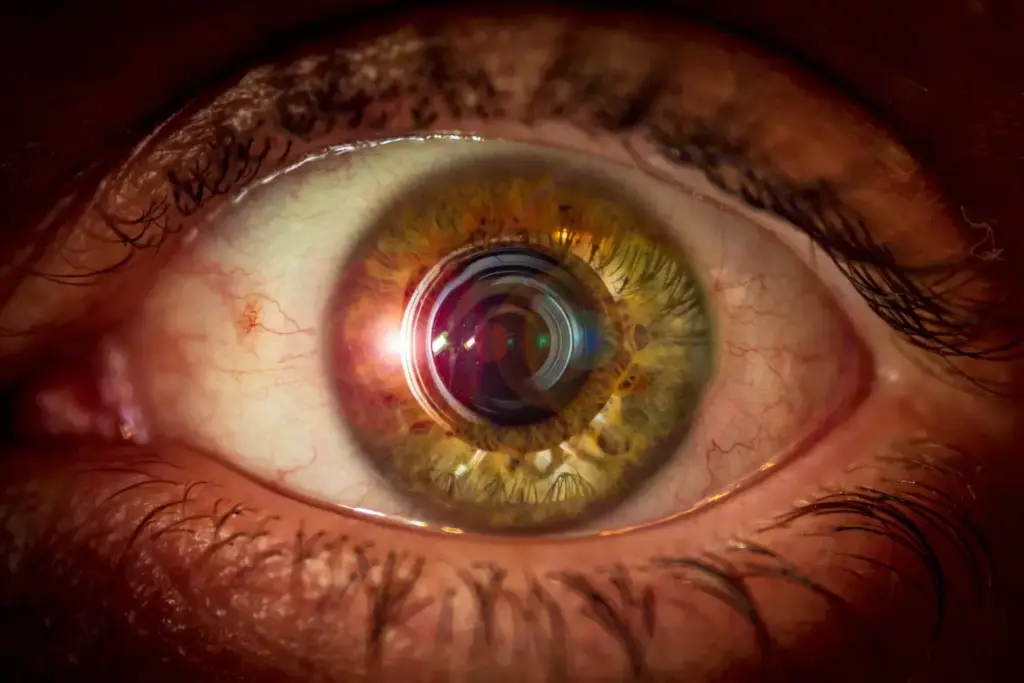Last Updated on November 5, 2025 by Bilal Hasdemir

Sudden changes in vision can be a warning sign of something more serious, like a brain tumor. At Liv Hospital, a trusted leader in patient-centered care, early recognition of brain tumor vision problems is central to prompt diagnosis and treatment.
We understand that vision changes can be a significant concern for individuals with brain tumors. In this article, we will explore the 9 key brain tumor vision problems, their symptoms, and warning signs.

Understanding the link between brain tumors and vision is crucial for early detection and treatment. Brain tumors can significantly impact vision by putting pressure on the optic nerve and affecting visual pathways.
When a brain tumor develops, it can cause a range of vision problems due to its location and size. The tumor can compress or damage the optic nerve, leading to symptoms such as swollen optic nerve (papilledema) and optic nerve swelling.
Brain tumors can affect visual pathways in several ways. The tumor can:
This can result in various vision changes, including blurred vision, double vision, and loss of peripheral vision. The specific symptoms depend on the tumor’s location and its impact on surrounding structures.
| Tumor Location | Potential Vision Impact |
|---|---|
| Near the optic nerve | Swollen optic nerve, vision loss |
| In the brainstem | Double vision, abnormal eye movements |
| In the occipital lobe | Visual field defects, hallucinations |
Vision changes caused by brain tumors can be sudden and severe. If left untreated, these changes can lead to permanent vision loss. Prompt medical evaluation is essential to determine the cause of vision problems and to initiate appropriate treatment.
We recommend that individuals experiencing sudden or severe vision changes seek medical attention immediately. Early diagnosis and treatment can significantly improve outcomes for patients with brain tumors.

Identifying the warning signs of brain tumor vision problems can lead to timely medical intervention and improved patient outcomes. Brain tumor vision issues can affect anyone, regardless of age, with certain types of tumors like optic nerve gliomas being more prevalent in children.
Vision disturbances associated with brain tumors can vary widely among patients. Common symptoms include blurred vision, double vision, and loss of peripheral vision. These symptoms occur because the tumor can press on the optic nerve or other parts of the brain involved in processing visual information.
Vision symptoms are relatively common in patients with brain tumors. Studies have shown that a significant percentage of patients experience some form of visual disturbance.
| Vision Symptom | Percentage of Patients |
|---|---|
| Blurred Vision | 40% |
| Double Vision | 25% |
| Peripheral Vision Loss | 30% |
The prevalence of these symptoms highlights the importance of regular eye exams and neurological check-ups for patients at risk.
Certain populations are more vulnerable to brain tumors and associated vision problems. These include children, individuals with a family history of brain tumors, and those exposed to certain environmental factors.
Optic nerve gliomas, for example, are more common in children and can cause significant vision problems. Understanding these risk factors can help in early detection and management.
Among the various vision problems associated with brain tumors, blurred vision stands out as the most common complaint. Blurred vision can significantly impact a patient’s daily life, making everyday tasks challenging.
Tumor-related blurred vision can manifest in different ways. It may be:
These characteristics can help differentiate tumor-related blurred vision from other causes.
While blurred vision is a common symptom of brain tumors, it can also be caused by other conditions. We need to distinguish between these causes to provide accurate diagnoses.
Some key differences include:
Understanding these differences is crucial for timely and appropriate treatment.
We recommend that individuals experiencing persistent or severe blurred vision consult a healthcare professional for a comprehensive evaluation.
Double vision, or diplopia, is a distressing symptom that can occur when brain tumors affect the alignment of the eyes. This condition can significantly impact a person’s quality of life, making everyday tasks challenging.
Diplopia occurs when the eyes are unable to align properly, resulting in the perception of two images of a single object. This misalignment can be caused by brain tumors affecting the cranial nerves or the brainstem, which are crucial for controlling eye movements.
Tumor-induced diplopia can result from several mechanisms. Brain tumors can directly compress or invade the cranial nerves responsible for eye movements, leading to misalignment. Additionally, tumors can cause increased intracranial pressure, which can indirectly affect eye alignment.
We will explore the specific cranial nerves involved and how tumors impact their function. The cranial nerves controlling eye movements are complex and can be affected by tumors in various ways.
Brainstem tumors are particularly likely to cause diplopia due to their proximity to the cranial nerve nuclei. These tumors can affect the nerves that control eye movements, leading to double vision.
The following table summarizes the cranial nerves involved in eye movements and their functions:
| Cranial Nerve | Function |
|---|---|
| III (Oculomotor) | Controls most eye movements, eyelid opening, and pupil constriction |
| IV (Trochlear) | Controls superior oblique muscle, which rotates the eye |
| VI (Abducens) | Controls lateral rectus muscle, which abducts the eye |
Understanding the relationship between brain tumors and diplopia is crucial for diagnosis and treatment. By identifying the underlying cause of double vision, healthcare providers can develop effective treatment plans to manage symptoms and address the underlying tumor.
Experiencing sudden vision loss is a frightening event that necessitates urgent medical evaluation. We understand the severity of this symptom and the importance of acting quickly to address it.
Sudden vision loss can manifest as either complete or partial loss of vision. Complete vision loss refers to the total loss of visual perception in one or both eyes, while partial vision loss involves a decrease in visual acuity or field of vision. Both types can be associated with brain tumors, and it’s crucial to seek medical attention regardless of the extent of vision loss.
The distinction between complete and partial vision loss is significant because it can indicate different underlying causes and potentially different tumor locations. Our medical team is trained to evaluate these differences and provide appropriate care.
Certain brain tumor locations are more likely to cause sudden vision loss due to their proximity to critical visual pathways. Tumors affecting the optic nerve or optic chiasm can lead to rapid vision decline. Additionally, tumors in the brainstem or those causing increased intracranial pressure can also result in sudden vision loss.
Understanding the specific tumor location is vital for determining the best course of treatment. We utilize advanced imaging techniques to identify the tumor’s location and develop a personalized treatment plan to address the vision loss and the underlying tumor.
Peripheral vision defects and hemianopia are significant vision problems that can arise from brain tumors, affecting an individual’s ability to navigate their surroundings.
These vision defects occur when a brain tumor damages the visual pathways, leading to a loss of peripheral vision or hemianopia, which is a condition where half of the visual field is affected.
Visual field testing is a crucial diagnostic tool for detecting peripheral vision defects and hemianopia in brain tumor patients.
This non-invasive test measures the field of vision, detecting any defects or losses in peripheral vision.
Early detection through visual field testing can significantly impact treatment planning and patient outcomes.
Peripheral vision defects and hemianopia can have a substantial impact on a patient’s daily functioning and safety.
Simple tasks such as walking, driving, or even reading can become challenging due to the loss of peripheral vision.
Patients may need to adapt their daily routines and environments to compensate for their vision loss.
For instance, they may need to rely more heavily on assistive devices or modify their home environment to prevent accidents.
Papilledema, a condition characterized by swelling of the optic nerve, is often associated with brain tumors and increased intracranial pressure. This swelling occurs when the pressure inside the skull is transmitted to the optic nerve, causing it to become inflamed.
We will explore the detection methods for swollen optic nerves and discuss the relationship between papilledema and intracranial pressure, providing crucial insights into diagnosing and managing brain tumors.
Detecting papilledema involves a comprehensive eye examination, including:
Ophthalmoscopy is a critical tool for directly observing the optic disc and assessing the degree of swelling. Advanced imaging techniques help in understanding the underlying cause and extent of the condition.
Papilledema is closely linked to increased intracranial pressure (ICP), which can be caused by brain tumors. The swelling of the optic nerve is a result of the transmission of elevated ICP to the optic nerve sheath.
Understanding this relationship is vital for managing patients with brain tumors. Monitoring for papilledema can provide early indications of increased ICP, allowing for timely intervention.
| Detection Method | Description | Clinical Significance |
|---|---|---|
| Ophthalmoscopy | Direct visualization of the optic disc | Assesses the degree of optic disc swelling |
| Visual Field Testing | Evaluation of peripheral vision | Identifies defects associated with papilledema |
| MRI/CT Scans | Imaging of the brain and optic nerve | Determines the cause and extent of papilledema |
By understanding the causes and detection methods for papilledema, we can better manage brain tumor patients and potentially prevent severe vision loss.
Changes in color perception and contrast sensitivity are potential symptoms of brain tumors that affect patients’ quality of life. We will explore how these visual disturbances occur and their implications for brain tumor patients.
Color vision disturbances in brain tumor patients can manifest in various ways. Some patients may experience a general desaturation of colors, while others may have difficulty distinguishing between specific colors. The severity and nature of color perception loss can vary depending on the tumor’s location and size.
Research has shown that tumors affecting the visual pathway can lead to color vision deficiencies. For instance, a tumor compressing the optic nerve can cause difficulties in distinguishing between red and green colors. We will discuss the specific patterns of color perception loss and their correlation with tumor locations in more detail.
Diagnosing color vision abnormalities in brain tumor patients involves a series of tests. The most common method is the Ishihara test, which assesses the patient’s ability to distinguish between different colors. Other tests, such as the Farnsworth-Munsell 100 Hue Test, can provide more detailed information about the nature and severity of color vision deficiencies.
We use these tests to understand the extent of color vision disturbances and to monitor any changes over time. This information is crucial for managing the patient’s condition and improving their quality of life. By detecting color vision abnormalities early, we can provide timely interventions to support patients in adapting to their visual changes.
Brain tumors can cause a range of vision problems, including abnormal eye movements such as nystagmus and gaze palsies. These movements can significantly impact a patient’s quality of life, making it essential to understand their causes and implications.
Abnormal eye movements associated with brain tumors can manifest in different forms, affecting the patient’s ability to perform daily tasks. We will explore the types of tumor-related eye movement disorders and the diagnostic approaches used to evaluate these conditions.
Tumor-related eye movement disorders can be categorized into several types, including nystagmus and gaze palsies. Nystagmus refers to involuntary, rhythmic eye movements that can be horizontal, vertical, or rotary. Gaze palsies, on the other hand, involve limitations in eye movement, making it difficult for patients to look in certain directions.
These disorders can result from tumors affecting various parts of the brain, including the brainstem and cerebellum, which are crucial for eye movement control.
“The presence of nystagmus or gaze palsies in a patient can be a critical indicator of a brain tumor, necessitating thorough diagnostic evaluation.” – Neurologist
Diagnostic imaging plays a vital role in evaluating ocular motility issues related to brain tumors. Techniques such as MRI and CT scans are commonly used to assess the tumor’s location, size, and impact on surrounding brain structures.
| Imaging Technique | Advantages | Limitations |
|---|---|---|
| MRI | High-resolution images of soft tissues, excellent for tumor delineation | Contraindicated in patients with certain metal implants, longer examination time |
| CT Scan | Quick examination time, good for detecting calcifications and bone changes | Less detailed soft tissue imaging compared to MRI, radiation exposure |
Choosing the appropriate imaging technique is crucial for accurate diagnosis and treatment planning. We use these diagnostic tools to understand the extent of the tumor’s impact on eye movements and overall brain function.
Monitoring vision health and seeking timely treatment are crucial for managing brain tumor vision problems effectively. By understanding the symptoms and warning signs, patients can receive appropriate care, improving their outcomes and quality of life. Visual problems associated with brain tumors, such as brain tumor vision disturbances, can significantly impact daily functioning.
We emphasize the importance of being aware of changes in vision, including blurred vision, double vision, and peripheral vision defects, which can be indicative of brain tumours and vision issues. Timely medical intervention can help mitigate these visual problems brain tumor patients often face.
At our institution, we are committed to providing world-class healthcare with complete support for international patients. Our team is dedicated to delivering personalized care, ensuring that each patient receives the appropriate treatment for their specific condition, including visual problems associated with brain tumors.
Brain tumors can cause a range of vision problems, including blurred vision, double vision, sudden vision loss, peripheral vision defects, and abnormal eye movements. We understand that these symptoms can be distressing, and it’s essential to seek medical attention if you experience any of these issues.
Brain tumors can put pressure on the optic nerve, leading to swelling, damage, or even vision loss. We use advanced diagnostic techniques to assess the optic nerve and determine the best course of treatment.
Papilledema is a condition characterized by swelling of the optic nerve, often due to increased intracranial pressure associated with brain tumors. We discuss the detection methods for swollen optic nerves and the relationship between papilledema and intracranial pressure in our article.
Yes, brain tumors can cause double vision, or diplopia, when they affect eye alignment. We explore the mechanisms behind tumor-induced diplopia and discuss the role of brainstem tumors and cranial nerve involvement.
Brain tumors can cause color vision disturbances and contrast sensitivity changes. We examine the patterns of color perception loss and discuss the testing methods for color vision abnormalities.
Certain populations are more vulnerable to vision problems associated with brain tumors. We discuss the risk factors and vulnerable populations in our article, highlighting the importance of early detection and timely medical intervention.
We provide comprehensive information on managing vision problems caused by brain tumors, including the importance of visual field testing, diagnostic imaging, and timely treatment. Our team is committed to providing world-class healthcare with complete support for international patients.
Peripheral vision defects and hemianopia are significant vision problems associated with brain tumors. We discuss the role of visual field testing in diagnosing brain tumors and explore the impact of these vision defects on daily functioning and safety.
Yes, abnormal eye movements, including nystagmus and gaze palsies, can result from brain tumors. We discuss the types of tumor-related eye movement disorders and explore the diagnostic imaging techniques used to evaluate ocular motility issues.
Monitoring vision health is crucial in brain tumor patients to detect any changes or problems early on. We emphasize the importance of seeking timely medical treatment for brain tumor vision problems to improve outcomes and quality of life.
Subscribe to our e-newsletter to stay informed about the latest innovations in the world of health and exclusive offers!
WhatsApp us